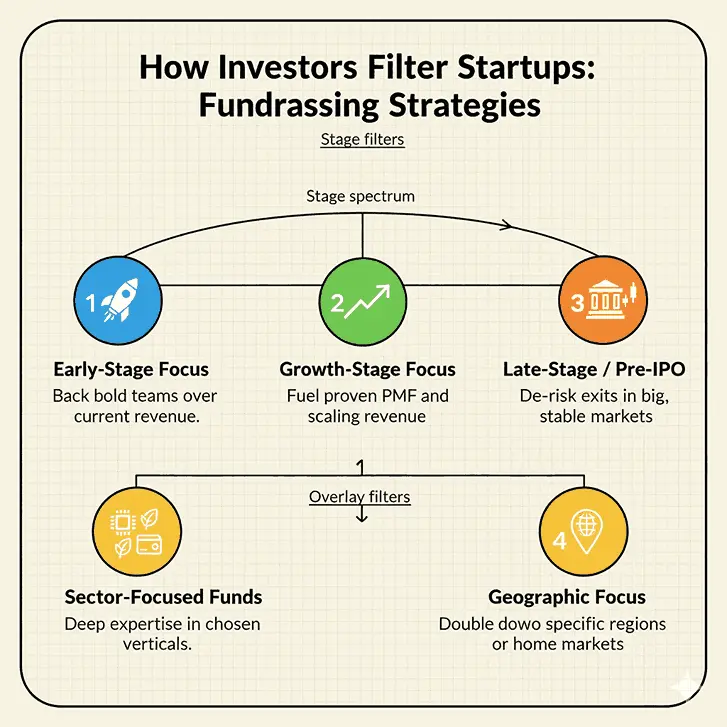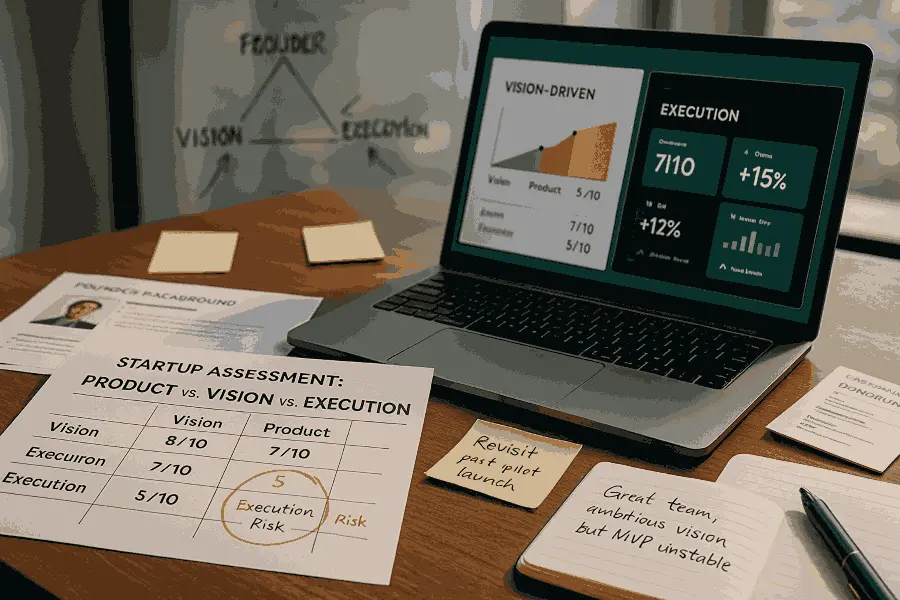Investors sit on top of a huge funnel and use strategy fit to cut it down fast. The average VC reviews around one thousand decks per year and funds roughly one to two percent of them. Most seed deals now come through warm introductions and curated pipelines, with cold email response rates stuck near one to five percent. At the same time, fund structure forces sharp filters around stage, check size, and sector.
Larger funds need big ownership in later stage or capital intensive bets, while newer managers may hard code ultra narrow mandates, such as only backing inception stage AI and infrastructure software companies. Newer managers often encode very narrow mandates, such as exclusively backing inception stage artificial intelligence and infrastructure software startups.
This guide clarifies how investors apply these filters in practice so your sourcing, screening, and allocation choices stay deliberate and aligned.
Let's dive straight into it!
How Investors Filter Startups: Fundraising Strategies
Every investor, whether a large venture firm, a micro VC, or an angel, operates with a guiding strategy shaped by philosophy, mandate, and practical realities. The most common strategies include:

- Early-Stage Focus: Funds that target seed, pre-seed, and Series A opportunities, typically favoring bold ideas, emerging markets, and strong founding teams over current revenue or traction.
- Growth-Stage Focus: These investors look for scale-ups with proven product-market fit, predictable revenue streams, and a need for capital to accelerate expansion and market penetration.
- Late-Stage/Pre-IPO Focus: Here, funds seek mature companies on the cusp of exit events. The emphasis is on stability, big markets, and reducing risk.
- Sector-Focused (Vertical) Funds: Funds may concentrate on fintech, heathtech, SaaS, climate tech, or other verticals, developing deep expertise and networks within those domains.
- Geographic Focus: Some funds emphasize growth regions (e.g., Southeast Asia, Africa) or stick to home markets, leveraging localized knowledge.
Startups that align perfectly with a fund's thesis advance fastest and get more favorable terms. Your discussion connects naturally to the article on startup scouting strategies by providing foundational context that broadens your understanding of early-stage evaluations.
Investor Goals and Expectations
The ultimate goal is to realize returns that satisfy Limited Partners (LPs—investors who commit capital to the fund) and the fund’s mandate.
- Target IRR (Internal Rate of Return) or MOIC (Multiple on Invested Capital)
- Expected holding period before exit
- Tolerance for risk and failure rates
- Desired ownership stake and control mechanisms
Startups that align perfectly with a fund's thesis advance fastest and get more favorable terms.
Fund Size and Investment Horizon Considerations
The size and structure of the fund deeply impact filtering:
- Large funds seek sizable opportunities to deploy capital efficiently and may need startups capable of scaling to “unicorn” status.
- Micro funds can thrive in niche markets or smaller exits.
- Venture studios may seek to incubate ideas themselves, imposing even more selectivity.
Recent benchmarks clarify scaling expectations. In 2024, median U.S. seed round size reached $2.5M, typically valuing startups at $14–16M pre-money. These figures guide both fund allocation strategies and startup fundraising approaches.
Criteria Investors Use to Filter Startups
Filtering isn’t random; it’s how investors filter startups using hard-won experience, repeatable frameworks, and careful deliberation. Here are the main criteria:
1. Market Potential and Size
In 2024, AI startups captured 33% of all global venture funding, setting a pace traditional sectors struggle to match. Such metrics highlight sectoral expansion as filter criteria. Investors start by asking whether the problem sits in a market big enough to deliver fund level outcomes, not just nice returns. They assess total addressable market, realistic serviceable slices, and category growth to see if winners can actually move the portfolio needle.
A compelling startup in a tiny or stagnant market usually fails this filter, no matter how strong the product or founding team.
2. Team Capability and Experience
- Founder-market fit: Does the team have unique insights, firsthand problem experience, or proven domain knowledge?
- Execution ability: Track record, complementary backgrounds, and cohesive culture can outshine even superior ideas.
- Resilience and Adaptability: Can the team pivot in response to market feedback or adversity?
3. Product-Market Fit
Is there clear evidence that customers want what the startup is selling?
- Traction Metrics: Revenues, users, partnerships, or customer testimonials.
- Engagement and Retention: Repeat usage, low churn, or viral growth all signal real value.
4. Financial Metrics and Projections
While tolerance for weak numbers is higher at early stages, investors want to see:
- Realistic and ambitious forecasts
- Gross margins, burn rate, CAC (Customer Acquisition Cost), LTV (Lifetime Value)
- Pathways to profitability or significant value-creating milestones
5. Competitive Positioning
How is the startup differentiated?
- Moats (Intellectual property, network effects, regulatory advantages)
- Barriers to entry for competitors
- Unique technology or market approach
5. Alignment with Fund’s Sector and Stage Focus
The most promising startups for a particular fund fit its exact sector, geographic, and stage sweet spots. If the fit isn’t right, even for a great business, investors will pass.
The Fundraising Fit Triangle Framework
Building on these filtering criteria, the Fundraising Fit Triangle framework emphasizes the importance of alignment between founder, investor, and market fit. This approach recognizes that successful fundraising depends not only on product or traction, but on how well the founder’s vision, the investor’s strategy, and the market opportunity intersect. Applying this framework helps both startups and investors assess mutual fit more holistically, leading to stronger partnerships and more effective capital deployment.
Due Diligence Process
Filtering starts even before diligence, with coarse screens. Robust due diligence is how leading investors separate signals from noise.
The process typically includes:
1. Initial Screening Methods
- Reviewing pitch decks and executive summaries
- Introductory calls or meetings to surface major disqualifiers
- Quick assessment of founder/investor “fit”
2. Use of Data Rooms and Documents
- Comprehensive analysis of financial statements, cap table, legal structure, and customer contracts
- Review of intellectual property, patents, and regulatory compliance
3. Reference Checks and Interviews
- Interviews with founders to test depth, vision, and cohesion
- Backchannel references with past employers, partners, and customers
- Assessment of team’s reputation and ability to attract talent
4. Validation of Market Assumptions
- Customer calls or surveys to validate pain points and willingness to pay
- Third-party market research to confirm size and trends
- Product reviews and hands-on tests
Diligence outputs are collated in internal memos and presented to investment committees, where the decision is finally made. Startups that align perfectly with a fund's thesis advance fastest and get more favorable terms.
Tools and Frameworks for Filtering Startups
Today’s investors use a blend of intuition, experience, and advanced tools to filter startups that align with their fundraising strategy.
1. Scoring and Ranking Models
Some funds use detailed scorecards to quantify their “fit” with investment criteria. Common scorecard parameters include:
- Team experience and background
- Market size and momentum
- Foundational technology
- Traction and growth rates
- Barrier to entry
- Culture and coachability
The team assigns each startup a weighted score, which standardizes comparisons and reduces subjective bias.
2. Use of AI and Automation
Increasingly, funds leverage machine learning algorithms to pre-screen applications. In 2024, AI is the heartbeat of today’s VC market, driving record investment and tool adoption. This positions automation as central to modern filtering.
- Machine learning algorithms to pre-screen applications and identify patterns in successful investments
- Natural language processing to scan for keywords or red flags in founders’ materials
- Automated data extraction from public sources, social media, and customer reviews
3. Deal Flow Management Software
Deal flow CRMs (such as Affinity, Seraf, DealCloud) organize meeting notes, documents, and emails, offering pipeline visibility and collaboration between partners. Integrated analytics show which sourcing channels produce the best opportunities.
Communication and Interaction
The filtering process is as much about how investors communicate as what they evaluate.
How Investors Engage with Startups During Filtering
- Initial outreach can be inbound (startup pitches investor) or outbound (investor discovers startup via networks, demo days, etc.)
- Investors may request further data or clarification at various stages
- “Soft diligence” sometimes assesses how responsive and transparent the founders are
- For shortlisted startups, investors often arrange site visits, in-depth meetings, and workshops
Importance of Transparency and Responsiveness
- Investors value startups who are prompt, honest, and forthcoming with both good and bad information
- Good communication practices can tip the scales in a tight decision
Common Challenges in Filtering Deals
Filtering is essential, but not always easy.
Occasionally, groundbreaking startups may be filtered out if they don't fit established criteria, highlighting risks of rigid frameworks.
1. Noise from Irrelevant or Poorly Matched Startups
- Large investors may see thousands of deals annually, many of which do not remotely fit their mandate. Developing effective filters and leveraging networks for warm introductions becomes vital.
2. Time and Resource Constraints
- Most funds have lean teams, so time must be allocated carefully. Initial filtering to quickly disqualify low-fit companies is crucial.
3. Managing Biases and Subjective Judgment
- Gut instinct and reputation are important, but must be balanced with data and process consistency.
- There’s risk in “pattern-matching” to past winners too rigidly, which may cause missing out on genuinely disruptive, unconventional ideas.
Tips for Startups to Match Investor Criteria
As a founder, you can dramatically improve your fundraising odds by understanding the filters investors apply and tailoring your approach. Here’s how:
Prioritize Targeted, Authentic Investor Engagement
Building on this foundation, founders should prioritize targeted, authentic engagement with investors rather than broad, high-volume pitching. Focusing on investors whose interests and values align with your startup increases the likelihood of meaningful conversations. Personalized outreach demonstrates respect for the investor’s time and signals a thoughtful, strategic approach. This strategy often leads to deeper relationships and more successful fundraising outcomes.
- Research fund strategies: Study investor portfolios, blogs, and theses. Focus your outreach only on funds whose interests align with your company’s stage, sector, and geography.
- Prepare clear, targeted materials: Highlight your competitive edge, market traction, and strategic fit up front. Make it easy for investors to see why you’re a match.
- Demonstrate coachability: Be transparent about risks and acknowledge what you don’t know. Investors value honesty, reflection, and the ability to grow.
- Build relationships early: Attend ecosystem events, engage on social media, or seek introductions well before you need money.
- Align your data room with investor needs: Anticipate what investors want to see (e.g., metrics, forecasts, founder bios, customer feedback).
- Show responsiveness: Quickly answer investor questions and provide materials promptly.
Use Community and Peer Support
Beyond individual preparation, founders can benefit from engaging with peer mastermind groups or supportive communities. These groups provide a forum to share fundraising strategies, receive feedback, and maintain motivation during challenging periods. Regular interaction with peers fosters innovation, accountability, and resilience, which are essential for sustained fundraising success.
Conclusion
The art of venture investing is as much about the deals you refuse as the ones you pursue. Understanding how investors filter startups is essential for both investors and founders. For investors, evolving these filters with market trends and using both data and intuition ensures not only that the right startups are selected, but also that capital is used to shape the next generation of industry leaders.
If you’re looking to seamlessly connect with startups that meet your investment criteria, we at Qubit Capital can assist with our comprehensive Startup Matchmaking service. Let us help you find the right opportunities tailored to your goals.
Key Takeaways
- Investors filter startups rigorously to ensure alignment with their fundraising strategy, optimizing for stage, sector, market size, and risk profile.
- Understanding an investor’s fund size, goals, and investment horizon is crucial for startups seeking capital.
- Core filtering criteria include market potential, team strength, product-market fit, financial health, competitive advantage, and strategic alignment.
- Due diligence involves multi-layered analysis, from initial screening to deep dives including reference checks and market validation.
- Modern investors increasingly rely on tools like scoring models, AI, and deal flow management software for efficient, consistent filtering.
- Open, transparent communication and responsiveness from startups can positively influence filtering outcomes.
Frequently asked Questions
How do investors use scorecards to filter startups?
Investors use scorecards to objectively evaluate startups on criteria like team, market size, traction, and strategic fit. Each factor gets a weighted score, enabling data-driven filtering.






